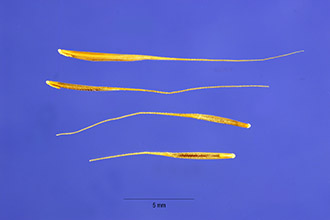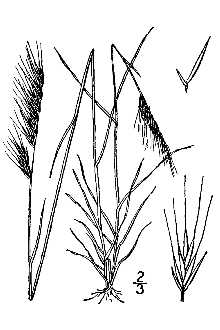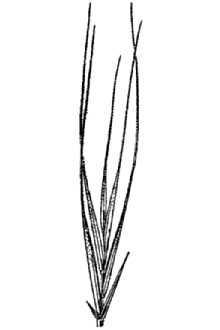Vulpia myuros (L.) C.C. Gmel. var. myuros
Scientific Name: Vulpia myuros (L.) C.C. Gmel. var. myuros

| General Information | |
|---|---|
| Usda Symbol | VUMYM2 |
| Group | Monocot |
| Life Cycle | Annual |
| Growth Habits | Graminoid |
| Native Locations | VUMYM2 |
Plant Guide
Alternative Names
Rat-tail fescue, foxtail fescue
Uses
Erosion Control: Annual fescue has an excellent fibrous root system that provides soil stabilization on natural and man-made disturbed areas. It will provide initial erosion control and as the site improves in condition, will allow climax species to invade. Cover Crop: Annual fescue has proved to be a valuable cover crop in almonds and other crops where a shorter height is required and mowing is frequent. It increases water penetration in problem orchards and provides a self-perpetuating cover. In comparison trials, it took more abuse than Blando brome (Bromus mollis) and produced less residue. Wildlife: Its early green growth provides some value for wildlife food, nesting and good cover in the spring season.
Status
Please consult the PLANTS Web site and your State Department of Natural Resources for this plant’s current status (e.g. threatened or endangered species, state noxious status, and wetland indicator values). © 2002 James B. Gratiot CalPhotos
Weediness
Annual fescue is irregularly scattered in the West in wasteland, fields, and overgrazed areas. This plant may become weedy or invasive in some regions or habitats and may displace desirable vegetation if not properly managed. Please consult with your local NRCS Field Office, Cooperative Extension Service office, or state natural resource or agriculture department regarding its status and use. Weed information is also available from the PLANTS Web site. Please consult the Related Web Sites on the Plant Profile for this species.
Description
General: Grass Family (Poaceae). Annual fescue is an introduced, short, aggressive, early maturing cool season annual grass with many fibrous roots. It has excellent seedling vigor and emerges in fall very soon after the first rain. It matures seed earlier than most annual grasses, assuring perpetuation. It can tolerate soil problems of acidity, serpentine, and low fertility. This species is native to Asia and Europe. Distribution: This species can be found in California, Oregon, Washington, Idaho, Nevada, Arizona, Texas and in several localities on the East Coast. For current distribution, please consult the Plant Profile page for this species on the PLANTS Web site.
Adaptation
Annual fescue is a drought tolerant grass that will persist and provide good erosion control cover with an annual precipitation of at least 25cm. (10 in.), or on areas receiving extra run-in moisture, and on areas receiving some supplemental irrigation. It has persisted on sites up to 1365 m. (4500 ft) and tolerates highly acid sedimentary soils and acidic mine spoils (pH 4.5). It germinates and grows in low fertility and shallow soils.
Establishment
The optimum time for seeding is between October 1 and November 15, Loosening the soil surface before seeding and covering lightly produces the best stands, Seed can be hydro-seeded, but best establishment occurs when the seed is in contact with the soil, Recommended seeding rates on critical areas are: broadcast, hydroseeded-3 pounds pure live seed per acre; drilled- 2 pounds pure live seed per acre and depth should be 1 to 2 cm (0,5 to 1 inch), Seed can be drilled or broadcast, but because of its size and shape, it tends to stick together, Rice hulls and/or a good companion seed will help prevent “bridging over,” and allow proper dispersion of seed, Use soil moisture sensors to measure the soil moisture of Vulpia myuros (L.) C.C. Gmel. var. myuros., There are about 993,700 seeds per pound,
Management
Applying 40 pounds of nitrogen per acre every other season during October or November will maintain healthy, erosion resistant stands. Annual fescues are initial invaders, so as sites improve, taller, more enduring plants will probably replace annual fescue, unless the area is mowed or grazed. In cover crop planting, annual fescue can be mowed frequently, but should be allowed to produce mature seed for continued perpetuation. It is readily controlled by several herbicides, providing assurance that it will not become a troublesome weed.
Seeds and Plant Production
Plant Production
Plant Production
Annual fescue has been grown in large-scale seed increase blocks at the Lockeford Plant Materials Center for the last three years. Seed was planted at a 3 lb./acre rate in 30 inch rows with a Planet Junior planter. Broad-leaf weed control herbicides are used. Seed is combined directly with an Allis Chalmers All-Crop Harvester, Model 72. Shattering is a problem at harvest time, so the seed is usually harvested while still a little green. Therefore, seed has to be dried in the field or a dryer before cleaning. Also, seed can be harvested using a flail-vac harvester.
Control
Please contact your local agricultural extension specialist or county weed specialist to learn what works best in your area and how to use it safely. Always read label and safety instructions for each control method. Trade names and control measures appear in this document only to provide specific information. USDA, NRCS does not guarantee or warranty the products and control methods named, and other products may be equally effective. Cultivars, Improved, and Selected Materials (and area of origin) ‘Zorro’ Cultivar- Seed for this cultivar was collected from native plants on droughty strips of a Colombia fine sandy loam at the Plant Materials Center, Lockeford, California. This collection was assigned as P1-109-71 and named Zorro in December 1976. It has excellent seedling vigor and has shown superior seedling establishment compared to ‘Blando’ soft brome (Bromus mollis) on infertile, shallow or droughty soils where erosion control is critical. It matures seed about 10 days to two weeks earlier than Blando (in May-June) if moisture conditions are normal. This earlier maturity assures perpetuation in droughty and low rainfall areas. Contact your local Natural Resources
Conservation
Service (formerly Soil Conservation Service) office for more information. Look in the phone book under ”United States Government.” The Natural Resources Conservation Service will be listed under the subheading “Department of Agriculture.”
Plant Traits
Growth Requirements
| Temperature, Minimum (°F) | 17 |
|---|---|
| Adapted to Coarse Textured Soils | Yes |
| Adapted to Fine Textured Soils | Yes |
| Adapted to Medium Textured Soils | Yes |
| Anaerobic Tolerance | None |
| CaCO3 Tolerance | High |
| Cold Stratification Required | No |
| Drought Tolerance | High |
| Fertility Requirement | Low |
| Fire Tolerance | None |
| Frost Free Days, Minimum | 80 |
| Hedge Tolerance | None |
| Moisture Use | Low |
| pH, Maximum | 7.6 |
| pH, Minimum | 5.9 |
| Precipitation, Maximum | 18 |
| Precipitation, Minimum | 5 |
| Root Depth, Minimum (inches) | 12 |
| Salinity Tolerance | Low |
| Shade Tolerance | Intolerant |
Morphology/Physiology
| Bloat | None |
|---|---|
| Toxicity | None |
| Resprout Ability | No |
| Shape and Orientation | Erect |
| Active Growth Period | Fall, Winter and Spring |
| C:N Ratio | Low |
| Coppice Potential | No |
| Fall Conspicuous | No |
| Fire Resistant | No |
| Flower Color | Yellow |
| Flower Conspicuous | No |
| Foliage Color | Green |
| Foliage Porosity Summer | Dense |
| Foliage Porosity Winter | Porous |
| Fruit/Seed Color | Brown |
| Fruit/Seed Conspicuous | No |
| Growth Form | Bunch |
| Growth Rate | Rapid |
| Height, Mature (feet) | 1.5 |
| Known Allelopath | No |
| Leaf Retention | No |
| Low Growing Grass | No |
| Nitrogen Fixation | None |
| Foliage Texture | Fine |
Reproduction
| Propagated by Seed | Yes |
|---|---|
| Propagated by Sod | No |
| Propagated by Sprigs | No |
| Propagated by Tubers | No |
| Fruit/Seed Persistence | No |
| Seed per Pound | 700000 |
| Seed Spread Rate | Rapid |
| Seedling Vigor | High |
| Small Grain | No |
| Vegetative Spread Rate | None |
| Propagated by Corm | No |
| Propagated by Container | No |
| Propagated by Bulb | No |
| Propagated by Bare Root | No |
| Fruit/Seed Period End | Spring |
| Fruit/Seed Period Begin | Spring |
| Fruit/Seed Abundance | High |
| Commercial Availability | Routinely Available |
| Bloom Period | Late Winter |
| Propagated by Cuttings | No |
Suitability/Use
| Veneer Product | No |
|---|---|
| Pulpwood Product | No |
| Protein Potential | Low |
| Post Product | No |
| Palatable Human | No |
| Palatable Graze Animal | Low |
| Palatable Browse Animal | Medium |
| Nursery Stock Product | No |
| Naval Store Product | No |
| Lumber Product | No |
| Fodder Product | No |
| Christmas Tree Product | No |
| Berry/Nut/Seed Product | No |



